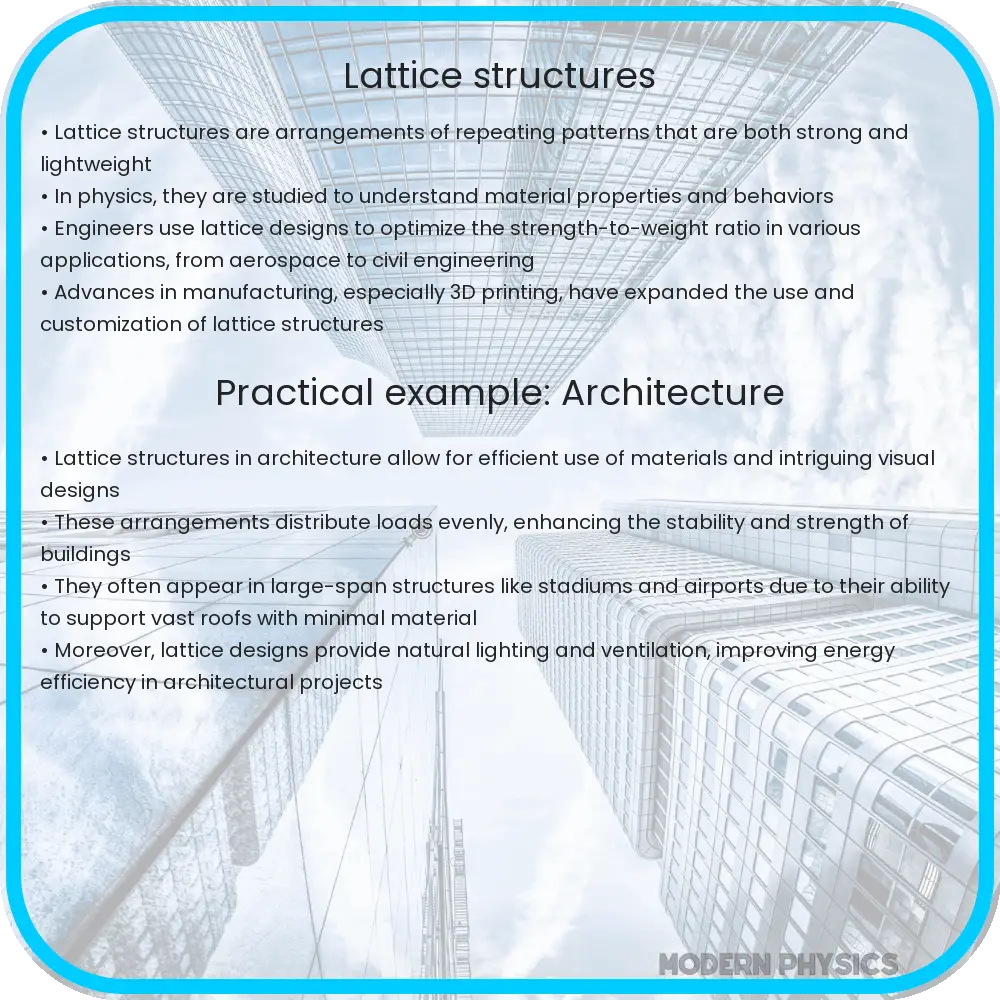Introduction to lattice structures, their design, strengths, and efficiencies in physics and engineering applications.

Introduction to Lattice Structures
Lattice structures are a fascinating and crucial area of study in both physics and engineering. These structures are arrangements of repeating units, typically in a three-dimensional grid pattern, which can be seen in materials science, architecture, and civil engineering. Their unique geometric configurations provide remarkable strength and efficiency for building materials and components. This article explores the concept of lattice structures, their inherent strengths, efficiencies, and how they are designed.
Understanding the Basics of Lattice Structures
At its core, a lattice structure is a repetitive network made up of one or more motifs (the smallest repeating unit) repeated at each lattice point in three-dimensional space. This repetitive nature can be found in various natural and synthetic materials. In metals, minerals, and polymers, for example, atoms themselves can form crystalline lattice structures, influencing the material’s mechanical properties such as strength and elasticity.
In engineering applications, particularly in the use of materials for construction and manufacturing, lattice structures are engineered to optimize certain desirable properties such as low weight, high rigidity, and good thermal conductivity. These properties are achieved by designing the shapes and connections of the lattice’s struts or nodes, which are typically interconnected in specific, often complex patterns.
Physical Strength and Efficiency
The strength of a lattice structure lies in its ability to distribute loads evenly throughout the entire framework. Unlike solid materials, where stress may be concentrated in particular areas, a well-designed lattice can spread out these forces, enhancing the structure’s overall strength and durability. This principle is crucial in architectural designs and in areas like aerospace engineering, where the objective is to ensure maximum strength while minimizing material usage and weight.
Moreover, these structures are not just about strength; they also contribute significantly to efficiency. Efficiency in lattice designs can refer to material use, energy absorption, and weight reduction. An intelligently designed lattice utilizes minimal material to achieve maximum strength and functionality. This attribute is particularly important in industries aiming to improve sustainability and reduce costs through efficient use of materials.
Design Principles in Lattice Structures
Designing effective lattice structures requires understanding the interplay between the geometry of the lattice, the properties of the material used, and the anticipated loads and stresses. Key design principles include:
- Unit Cell Design: The choice of the unit cell — the smallest repeatable section of the lattice — is crucial. The shape and size of the unit cell determine the overall geometric and mechanical properties of the lattice.
- Material Selection: Different materials impact the behavior of the lattice structure under various conditions. Engineers must select a material that complements the designed geometry to optimize performance.
- Manufacturing Constraints: The manufacturability of a lattice structure is also a significant consideration. Advances in manufacturing techniques, like 3D printing, have expanded the possibilities for complex lattice designs.
These principles guide the engineering of lattice structures for specific applications, balancing between theoretical design and practical implementation challenges.
Applications of Lattice Structures
Lattice structures find broad applications in various fields due to their unique properties. Some key areas where these structures are instrumental include:
- Aerospace: In aerospace engineering, the lightweight and high strength of lattice structures contribute to the efficiency and performance of aircraft and spacecraft parts, reducing overall weight while maintaining structural integrity.
- Medical Devices: Lattice structures are used in the design of prosthetics and implants. Their ability to mimic bone structure allows for better integration with human tissue, improved comfort, and functionality for the users.
- Architectural Engineering: In architecture, lattice structures allow for creating large, open spaces without columns, leading to innovative building designs that are both aesthetically pleasing and functionally superior.
- Automotive: The automotive industry utilizes lattice structures to fabricate parts that are robust yet lighter, improving fuel efficiency and reducing emissions without compromising safety.
Challenges and Future Prospects
Despite their advantages, designing and implementing lattice structures come with challenges. The complexity involved in optimal design and the need for precise manufacturing techniques like 3D printing can be cost-prohibitive. Additionally, understanding the dynamic behaviors under varying loads and environmental conditions continues to be an area of intensive research.
The future of lattice structures looks promising with ongoing advancements in computational design tools and manufacturing technologies. Continual improvement in materials science also paves the way for even more innovative applications, making lattice structures more accessible and effective for a wider range of applications.
Conclusion
Lattice structures represent a perfect union of form and function, blending architectural beauty with engineering integrity. Their ability to distribute loads efficiently and maximize strength while using minimal materials makes them a staple in both natural and engineered systems. From supporting aerospace innovations to enhancing medical devices, the potential uses of lattice structures continue to expand. As technology advances, so too will the capabilities and applications of these fascinating structures, promising new horizons in both design and functionality.
